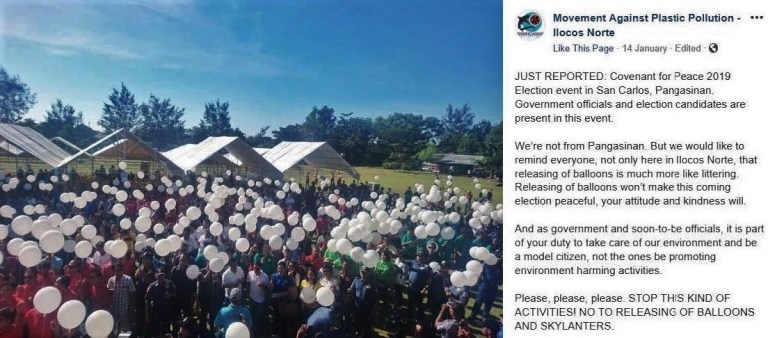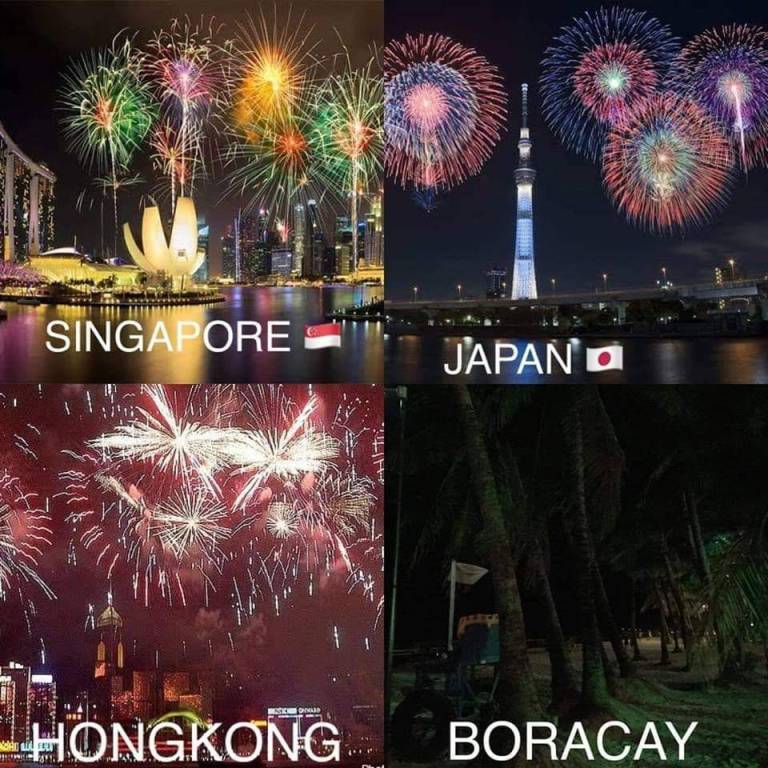Balloons, Confetti and Fireworks; is it time to stop?
Balloons, Confetti and Fireworks have long been part of any celebration planning. Leading up to the 2019 New Year countdown, the Philippines was at the forefront of a netizen protest over a ‘Record Breaking’ Balloon Drop event at a Manila Nightclub. As well as some upset that the fireworks ban on Boracay would remain in place, even for New Year.
January is Zero Waste Month and more attention is now being given to the issue of stopping single-use plastics and other trash finding its way in to landfill and our Oceans.
“There are approximately 51 trillion microscopic pieces in the ocean weighing 269,000 tons. That’s as much as 1,345 blue whales.” Plastic Pollution Statistics & Facts 2022
Is it time for us to stop with the Balloons, Confetti and Fireworks, which have become a typical component of any celebrations in the Philippines?
The Cove Manila effect: Balloon Drops
In December 2019 Cove Manila released event posters listing a ‘Record Breaking’ Balloon Drop attempt, as part of their New Years Eve Party celebrations. The event, which included a set from International DJ Pete Tong, was promoted on their Facebook page. But it is safe to say they didn’t get the result they expected.
Thousands of Filipino’s vented on Cove Manila’s original post, and on the nightclubs statement releases which followed, in response to the netizens angry reactions.
At first (29th December) Cove Manila attempted to justify the balloon drop [1.] claiming it would be an accolade for the Philippines, with a Guinness Book of Records award. A claim they clung to throughout the whole saga. Netizen’s quickly pointed out that the Guinness Book of Records states on their website [2.] that Balloon Drops and Releases were no longer recognised (see Gallery).
Another point given was that the balloons were ‘biodegradable’ but the nightclub was unable to give details of the components of the balloons. And many people, more aware, pointed out that even biodegradable balloons can take anywhere between 8-50 years to biodegrade. Even then leaving residue micro-plastic. Cove Manila also advised, in their statement, that they had already arranged for the balloons to be collected after the event, to be recycled.
Regardless, the Department of Environment and Natural Resources (DENR) stepped in requesting that Cove Manila shelve the balloon drop idea [3.], and the organziers complied.
Not only Cove Manila but several other Manila Hotels that had also planned to have a Balloon Drop for New Years Eve, unnoticed by the keyboard warriors


And then a Balloon Release!
Those who shared their outrage online, and watched as national and international media ran with the story, may have hoped it was a lesson learned. That organizers may rethink the use of balloons for celebrations or gimmicks.
On the same day that it all kicked-off for Cove Manila, Davao Bamboo Sanctuary and Ecological Park also drew flack for a planned Balloon Release event, as part of their New Year celebrations. Yes, you did read that right; an Ecological Park had planned to release hundreds of balloons in to the environment, and their own grounds.
Ahead of the cancellation of the event the advocacy group Climate Reality Project Philippines called the decision to hold such an event as “utter arrogance”:-
“We remind the organizers that all balloons released will end in areas which will harm wildlife, marine and terrestrial ecosystems and even clog sewage systems, among others. This is intentional violation of the Ecological Solid Waste Management Act of RA 9003” Climate Reality Project Philippines [4.]
Davao Bamboo Sanctuary and Ecological Park were certainly a lot quicker to drop their planned balloon activity than Cove Manila; releasing a statement on the same day that they would not proceed with the Balloon Release.
But not less than two weeks later the group Movement Against Plastic Pollution – Ilocos Norte [5.] posted online about the Convent For Peace 2019 Election Balloon Release, taking place in San Carlos, Pangasinan. Present for the release were Government Officials and Election Candidates.
Obviously the gesture is understood; white symbolizes peace and it was done to suggest a commitment to peaceful election campaigns. But as Movement Against Plastic Pollution pointed out:
“Releasing of balloons won’t make this coming election peaceful, your attitude and kindness will.
And as government and soon-to-be officials, it is part of your duty to take care of our environment and be a model citizen, not the ones promoting environment harming activities”

So some drops or releases were cancelled, some still went ahead. The fact remains that in all cases the balloons had already been ordered and received, ahead of the events and still needed to be disposed of.
Exactly how biodegradable are Biodegradable balloons?
Anna Varona, of Clean our Oceans Project (CoOP), offered the following questions to Cove Manila, on the 29th December in response to their claims that the balloons were biodegradable and would be recycled:
1. How biodegradable? In what conditions?
2 Do they biodegrade according to PNS (Philippine National Standards) standards?
On the 6th January, in a follow-up to her post, Anna added:
“Clean Our Oceans Project is about lessening your plastic use and decreasing plastics in the ocean first. Clean Our Oceans project advocates up-cycling as an alternative that prevents plastics from entering the Marine ecosystem. It is a transition from the current system we have of dumping in landfills and rivers. It is an alternative while people get used to the idea of managing their own waste, getting government help to make segregation easier and used to the idea of alternative disposal systems.”
On the 30 December, Clean Our Oceans Project was invited to visit Cove Manila, to inspect the material of the balloons and advise what could be done with them. Anna noted at the time that it was possible that the balloons could be incorporated into the manufacture of school chairs, which Okada could then donate to surrounding schools. She added that:
“In 2004 there was a shortage of 4.5m school chairs in the Philippines. With our increasing population I surmised a rising need.” Anna Varona
Whilst ‘Natural latex’ may be biodegradable in its original state, once chemicals, plasticizers, and artificial dyes have been added in order to produce balloons, it impacts on how well the balloon can biodegrade or be recycled/ upcycled.
CoOp asked to be provided with photos of the balloon packaging, to aid their engineers in assessing the composition. So they could determine the best method to up-cycle the balloons but they are yet to hear back from Cove Manila. It is possible that the unused balloons will just be ‘waste managed’ or sold on.
Regardless, we can only hope that Cove Manila and others recognise that their stunt was a costly marketing mistake, both in terms of the money wasted for a stunt that didn’t go through. As well as to their reputation.
Sky Lanterns: La Vie in the Sky, Cebu
And it’s not just balloons; Sky Lanterns have seen a surge in appearance at events.
Yes, they look beautifully dramatic as they float up into the sky. But have a care for the absolute carnage that occurs when they come back down again, even when released over the ocean:
The organisers behind La Vie in the Sky, thankfully cancelled their planned Sky Lantern event, which had been organised to celebrate Sinulog on January 19th in Cebu. After a similar public outcry to that which Cove Manila experienced.
“Sky lanterns are made with plastic or lightweight paper and are lifted into the air when burning material is ignited at the base making it lighter than air. They can travel for more than a mile, whichever way the wind blows.
Sometimes the fuel is still burning when the device contacts a structure, a tree, or lands on the ground. Usually they are not retrieved and become someone else’s trash.” [6]. Wildfire Today
Whilst they’re not a Philippine tradition, Sky Lanterns are becoming increasingly popular for weddings, memorials and organised events here. But we need to recognise that they are not environmentally friendly; they don’t burn up to nothing but leave waste material and wires that cause harm not just to animals and marine life but also to homes, forest land and critical habitats.
Glitter, Glitter Confetti, Metallic Wedding Confetti
The majority of glitter is made from tiny pieces of PET plastic bonded to Aluminum; qualifying as micro-plastics. Glitter Confetti is the same but made with larger pieces. PET (Polyethylene Terephthalate) is a particularly worrying plastic as it can break down, releasing chemicals that can disrupt hormones in animals and humans.
Factor in that the glitter or confetti is designed to be small, this results in it also being small enough to pass through water filtration systems. Ending up in rivers, lakes, and oceans where it is eaten by fish, which are then eaten by humans.
In November 2017 Scientists recommended the banning of Glitter and Glitter Confetti, hot on the heels of the UK and USA’s decision to ban microbeads in beauty and health products.
“I think all glitter should be banned, because it’s micro-plastic….. When people think about glitter they think of party and dress-up glitter. But glitter includes cosmetic glitters as well, the more everyday kind that people don’t think about as much.” Dr Trisia Farrelly, an environmental anthropologist at Massey University [7.]
Should we ban glitter and glitter confetti from our lives?

Well it certainly isn’t much fun when you have to spend weeks washing it from your bed sheets and clothing or sweeping it up from your floor.
There is an alternative; Bio-Glitter by Lammana, created by Stephen Cotton. He replaced the PET component with a plant/tree based cellulose. But even if you select a glitter that doesn’t involve PET it does still include tiny amounts of Aluminum, which also litter the environment.
Even alternatives to wedding confetti aren’t always biodegradable or wildlife-friendly. The most traditional of all wedding confetti, dried rice, can be harmful to birds. Flowers or herbs used instead, are a slightly safer option but you still have to ensure that they’re not poisonous to birds and animals that may come into contact with it. Even Coconut Flake Confetti can cause problems, with a rising number of people who are allergic to coconut [9.]
Is New Year, New Year without Fireworks?
December 2018 saw a continued ban on Fireworks on Boracay Island. Boracay had only just come out of a 6 month closure after being labelled a “Cesspool” by the Philippine President. Ahead of the reopening of the island, it was decided that fireworks were to be banned before 9pm at night, so as not to cause unnecessary stress to the islands endangered Flying Foxes (Fruit Bats) during their evening migratory path.

One week before the re-opening of Boracay, the Inter-Agency Taskforce extended this to a complete blanket ban on fireworks, including New Years Eve. Whilst the Department for Environment and Natural Resources (DENR) voted in favour of New Years Fireworks, after residents and islanders requested consideration, the Department of Tourism (DOT) and Department of the Interior and Local Government (DILG) voted against it.
Boracay’s New Year celebrations were an anti-climax, commented on by tourists. Thousands of tourists and islanders lined the beach to watch the only fireworks to be seen; launched from Caticlan and Nabas shorelines. They were a long way away and couldn’t be compared with the spectacular White Beach firework displays of proceeding years, which had even featured on the BBC’s annual ‘New Year from Around the World’ feature.
With Boracay being groomed to be a Sustainable Tourism spot it probably wasn’t a complete surprise to residents and businesses that fireworks would be banned, even for New Years. Although many were left stunned when, within the same week the Department of Tourism triumphantly announced that 28 Cruise Ships would be visiting the island in 2019; one of the biggest polluting industries there is (read our article here: Cruise Tourism Impacts on the environment).
Are Fireworks really that bad?
Well it’s not just the noise which causes great distress to marine and wildlife. The fact is :-
- 60-75% of each Firework is shells and packaging; cardboard, wood, clay and plastic [10.].
- Each rocket consists of approximately 75% Potassium Nitrate, 15% Charcoal and 10% Sulfur, along with Copper, Barium or Strontium compounds for colour effects [10.]. These find their way into the soil and our water systems.
- Perchlorate is an Oxideser used in fireworks to create bright flashes of light. But it can dissolve in water and is harmful to both people and wildlife. It has also been linked to thyroid problems [11.]
- Fireworks include ingredients that are mined. Some of the mining for firework compounds involves the process of mountain top removal. In addition, forests on the mountains are clear/cut, destroying wildlife habitat and the waste rock is dumped into the valleys, burying natural valley streams [12.]
Basically, Fireworks cause metal particles, dangerous toxins, harmful propellant chemicals, colourants and smoke to be present in the air, water and soil surrounding the display area for hours and days. Some of these toxins never fully decompose or disintegrate, but stay in the environment, poisoning whatever they come in to contact with.


Two Firework displays over San Francisco Bay in 2016 resulted in National Park Service staff collecting four 50-gallon trash containers of charred fuses, plastic and cardboard pieces after the events, from the Bay area. Despite the clean up, a further 30 pounds of fireworks debris washed up on the shoreline one week later. And it continued to wash up for weeks [11.].
Certainly members of Boracay’s Dive Association have reported similar physical findings, New Years Day, when they dive to collect what debris they can find around the launch boats. The recoveries often include whole boxes of unused fireworks that were either knocked, or slipped off the launch boats during the display.
Some countries are introducing and enforcing the use of Silent Fireworks but, whilst the noise is reduced considerably, the environmental impacts remain unless organisers ensure they purchase fireworks that don’t contain the worst pollutants, such as Perchlorate.
The reality is that there are a lot of environmentally unfriendly practices which we’ve all become used to, whether because they are convenient to our fast-paced lifestyles (Plastic Bags, Disposable Nappies, plastic cups and containers for take out etc) or because they add to our general enjoyment of life. But many of these are not good for the World we live in and ultimately, they’re finding their way back in to our environment and our food.
We are poisoning the world and ourselves, with our careless attitudes to convenience and entertainment and maybe now is the time to stop, think and do something about it!
Article Sources:
- Cove Manila’s 29th December statement
- Guinness Book of Records
- DENR issues order to stop record attempt of largest balloon drop at Okada – Inquirer
- Eco-park cancels balloon release – SunStar Davao
- Movement Against Plastic Pollution – Ilocos Norte
- Sky lanterns possible cause of fires that burned 4 homes and a boat dock – Wildfire Today
- Glitter should be banned over environmental impact, scientists warn – The Independent
- Losing its sparkle: the dark side of glitter – The Guardian
- The 9 Dos and Don’ts of Eco-Friendly Wedding Confetti Tosses – Catalyst Wedco.com
- New Year’s Eve: Are fireworks harming the environment? – DW.com
- Do Fireworks Pollute the Bay? – San Franciso Baykeeper
- 5 Ways Fireworks Ruin Our Natural Resources – Backcountry Attitude


















GIPHY App Key not set. Please check settings